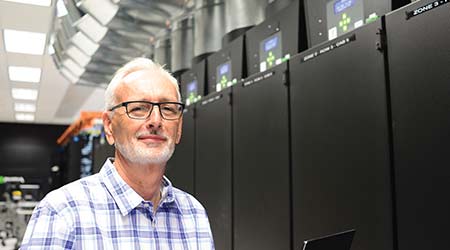 Bruce Thorpe, global lead, energy and critical environments, NVIDIA
Bruce Thorpe, global lead, energy and critical environments, NVIDIAHow To Team Up With IT To Manage Data Centers, Critical Environments
Building partnerships is essential to building out critical environments at Silicon Valley tech company, NVIDIA.
Bruce Thorpe describes his work thusly: “One day it’s self-driving cars, the next day it’s supercomputers. It’s a pretty typical FM day, but with very cool toys.” Thorpe, who is the global lead for energy and critical environments at Silicon Valley tech company NVIDIA, gets to play with cool toys, yes. But success in his position has come from his ability to earn the trust of his company’s IT department, the product teams, and upper management.
Thorpe’s job involves building partnerships to manage the company’s facilities, both critical and not. NVIDIA is best known for inventing and bringing to mass market the GPU (graphics processing unit) for computer gaming. The company’s technology is also used for artificial intelligence, virtual reality, data center servers, as well as other products, used by many of the world’s biggest companies, including Facebook and Microsoft. It’s as high-tech as tech companies get.
On its campus in Santa Clara, Calif., NVIDIA has data centers of its own, as well as several product testing labs. One of the most critical types is known as an emulation lab — these spaces are basically data centers but without the required redundancy. “If we lose power, we can simply restart the systems,” says Thorpe. “The machines look like layers and layers of servers, but they’re actually highly specialized emulators.”
Designing, building, and managing these emulation labs is one of the main thrusts of Thorpe’s responsibilities. As he describes it, “My role is to architect infrastructure based on information from our clients, which is the product teams.” The product teams use these labs to test their chipsets to make sure they’re ready for prime time.
“We joke with our industry peers about who has the biggest emulation lab,” says Thorpe. That’s a pretty good indication of the size and scope of Thorpe’s duties: Any time you’re in the conversation with these well-known Silicon Valley tech companies about which has more computing space, you’re in the big time.
And for Thorpe, it’s about to get even bigger time, as NVIDIA expands to a new state-of-the-art 500,000-square-foot building this fall. Imagine a system reporting energy data 8,000 times per second. That’s what Thorpe will be piloting in the new space. Well, technically, Thorpe won’t be doing much managing at all, if all goes well. That’s because the new space and its systems are to be largely automated — “the automation will be automated,” says Thorpe. That is, the building systems will run on a machine learning and artificial intelligence platform that learns about the building, and its operations, and optimizes them on the fly. This is truly next-level facility management. But it’s exactly what you’d expect from a fast-paced tech company.
Tech culture
As well, NVIDIA’s culture is truly forward-looking in many respects. For one, “leasing expertise,” as Thorpe calls outsourcing, is simply a matter of course. “We laugh a little bit about the argument about outsourcing,” says Thorpe. “That was settled here in Silicon Valley decades ago.” So Thorpe’s “department,” if you can call it that, is him and one other guy.
As another example of the Silicon Valley tech culture, the capital budget for energy and efficiency upgrades for the company’s owned data centers resides in the IT budget, not within facilities’. Thorpe says this advantage is one way the bridge of trust between he and IT is built. “It’s in their interests to be more efficient,” he says. “And you find a way to work together.”
This idea, Thorpe says, is absolutely crucial for anyone who manages the infrastructure of critical environments. “You have to have deep and trusting partnership with your IT people,” says Thorpe. “They have to trust you implicitly. And you have to build that trust over time. It’s my responsibility to do that. And it comes with an enormous obligation not to screw that up.”
As Thorpe says, this doesn’t happen overnight. Thorpe has been at NVIDIA for about six years, and says it’s something he works on everyday. The partnership only works if the relationship is advantageous to both parties. “They don’t want failures,” he says. “And they want to maximize use. They want [options] open to them.” That partnership has grown stronger by showing them how he can help them, and showing they truly have a vested interest in this relationship, as well, he says. “IT doesn’t always have a great of inventory of what they have in their racks,” he says. “And you can help them out with that.”
IT must know and understand the challenges of facilities and infrastructure as well. Thorpe says one example of this is when IT does quarterly patches. If a BAS is running on old platforms, the patches may not work, and the BAS goes “black screen.”
“So this is an opportunity to work hand in glove with IT,” Thorpe says. “Show them how what they’re doing will impact infrastructure. Get the vendor in and do a workaround, and then you find yourself in the same room with IT, working together.”
Related Topics:














